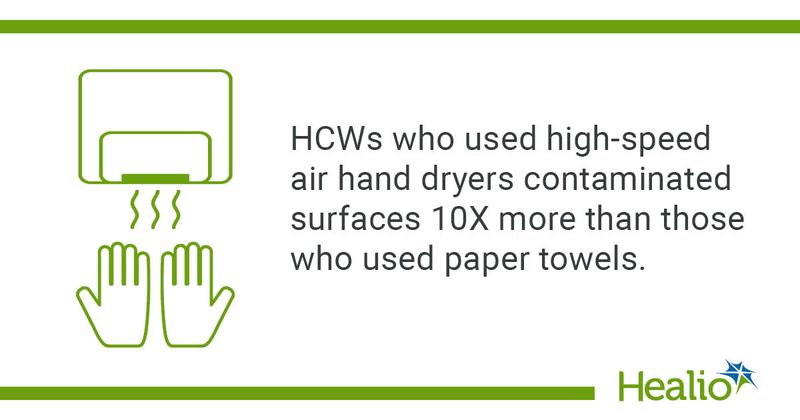High-speed air hand dryers leave HCW hands more contaminated than paper towels
Study results suggest that health care workers will spread fewer pathogens if they use paper towels to dry their hands rather than high-speed air hand dryers.
“Our group has previously investigated the impact of different hand drying methods in the contamination of the washroom/toilet environment in a hospital,” Ines B. Moura, PhD, research fellow at the University of Leeds, told Healio. “At the time, it was observed that air dryers resulted in a higher level of microbial dispersion across the washroom and the person drying the hands.”

Healio previously reported that air hand dryers, specifically automated ones in restrooms, can harbor and spread bacteria, including Staphylococcus and fecal matter. According to research presented during the 2020 ASM Microbe meeting, undergraduate students at Weber State University swabbed the dryers in three locations the top above the air vents, the middle beneath the air vents and the bottom of the dryer and found that the bottom of the dryers had the most contamination, although all three location contained organisms.
“I think there is certainly the possibility of thinking your hands are clean when they may have been inoculated with micrograms while being dried,” Craig Oberg, PhD, the Brady Distinguished Professor of Microbiology at Weber State University in Ogden, Utah, said at the time.
Moura and colleagues aimed to see if the use of hand dryers impacted the potential for microbes that remain on people’s hands and clothing after drying to spread to different areas of the hospital as surfaces were touched along the way. The researchers used bacteriophages as an indicator of microbial contamination to investigate whether microorganisms remain present on poorly washed hands or contaminate the user during hand drying and if they can be transferred beyond the bathroom to surfaces touched by health care workers (HCWs). The participants — one woman and three men — dried their hands with paper towels for 12 seconds using three to five towels and jet air dried their hands for 10 seconds on average.
The study demonstrated that both the jet air dryer and the paper towel methods significantly (P < .05) reduced bacteriophage contamination of the hands by 2 log10 copies/L and 3 log10 copies/L, respectively. However, the aprons they were wearing, which were used to simulate clothing, were contaminated by bacteriophages significantly more after jet air dryer use. Researchers said that all eight surfaces they investigated following jet air dryer use — including elevator buttons — had bacteriophage contamination above the limit of detection, whereas this occurred for only five of the surfaces tested after paper towel use. They determined that the average surface contamination was more than 10-fold higher after jet air dryer use than after paper towel use.
“Microbes that remain on hands or clothing following hand drying can transfer to multiple surfaces within the hospital. This is more likely to happen when hands are dried with air dryers compared with paper towels,” Moura said. “Our findings suggest that the method of hand drying available in public toilets is important to reduce microbial spread, particularly in health care settings.”
